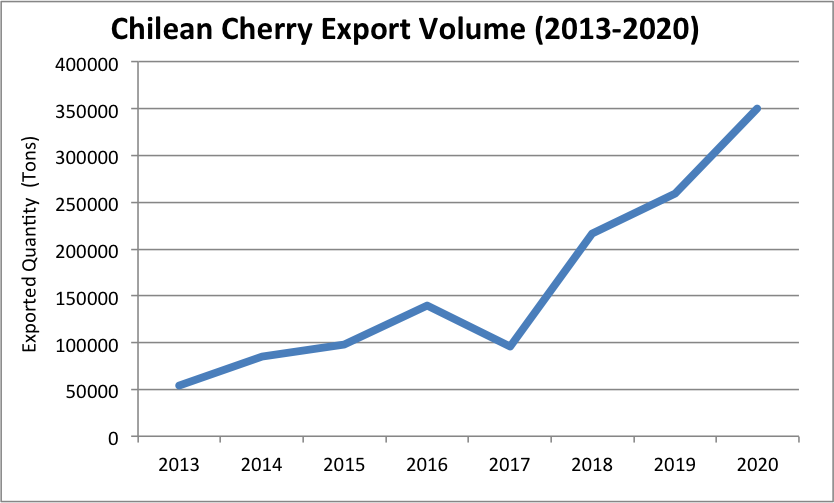In January of 2021, when the cherry season was at its peak, Chilean cherries were involved in what appeared to be a ‘fake news’ scandal, as it was announced that Chinese authorities found a batch of imported cherries that was COVID-19 positive. The news came as a devastating disaster to cherry exporters, traders, and retailers, and as a result, cherry prices began to plummet. However, despite this misfortune, the Chinese market showed no further concern for the virus, and consumption of the fruit rose, taking advantage of the historically low price. The season for Chilean cherries had its best performance in volume in a decade.
The Importance of Cherries in Chile
According to data from the Office of Agrarian Studies and Policies (Odepa), cherries were Chile's leading fruit export in terms of value, with around USD 1.35 billion collected in the last season until February of 2021 and represented 48.7% of the total fruit shipments in the country. Chile is the third-largest producer and largest exporter of cherries globally, commercializing 95% of all the cherries in the southern hemisphere.
The local cherry industry in Chile has reached an unprecedented size in recent years, as more than 4,000 hectares come into production each year. In recent years, the area planted in Chile has grown at a rate of more than 20%, and as cherry trees usually begin to bear fruit after three years, production will continue to increase even if the planted area remains the same. Of the 95% of cherries that Chile commercialized, 91% goes to their biggest market which is China.
China is the Largest Market for Cherries and Growing
Chile exported 330 thousand tons of cherries to China in the 2020-2021 season, with an increase of 43% from the previous season, accounting for 91.4% of all cherry exports. The Hong Kong Seaport Alliance (HKSPA) has reported a growth of 54% in all shipments that arrived at the Hong Kong port from either Valparaiso or San Antonio port for the 2020/21 Chilean cherry season, with the official record at the port of 71 million boxes exported this season.
Around 70% of the cherries in the world are consumed in mainland China, among which 90% are from Chile. This allows Chile to be the largest exporter of cherries with 36% of the world supply share, which is dictated by the increasing demand in the Chinese market. The Federation of Fruit Producers of Chile (Fedefruta) estimates that if demand in China keeps growing at this peace, Chile will possess more than half of the world’s cherry supply by 2023. China bought USD 2.3 billion during the 2020 calendar year, which means China keeps buying cherries from the Northern Hemisphere when Chilean cherries are out of season. Other cherry suppliers are the US that holds around 6% of the share, and Canada, with 2.5%.

Chilean Cherries Faced Hardship Over Peak Season
On January 21, it was disclosed on social networks that coronavirus was detected in one of the cherry boxes. Although several weeks later, the World Health Organization ruled out that it could be transmitted by food, it was too late. In two days, 400 million Chinese were exposed to this news, and the negative effect on Chilean cherries was immediate.
Fedefruta estimates that 20 to 25% of the cherry sold over the season was sold under production costs, which caused severe financial damage to cherry producers and exporters. The Guangzhou market’s wholesale price decreased down to USD 4.0 per/kg over the following weeks of the incident. Until the Chinese New Year, the price increased to USD 5.5 per/kg, which is still considerably lower than the average price of USD 8.5 per/kg.
Another negative effect was a strong decrease in the retail sales and the wholesales, the period when the highest sales were expected to occur. Despite strong public relations campaign efforts over the public and private sectors, wholesales weren´t able to reach the sales prices usually recorded in the previous seasons.
Positive Outcome Over Volume and Demand
Even though the export value decreased due to the virus incident, the demand for the fruit and the quick recovery of the Chinese economy has made the Chilean cherries close their season with record volume numbers. The Chinese New Year came into the exact time when Chilean cherries reached a lower value of USD 5.5 per/kg, earning a considerable amount of new clients that in normal conditions would not be able to buy the fruit in the first place.
Furthermore, with China’s increasing purchasing power, the demand for imported fruits has seen tremendous growth. Imports still only account for 2.5% of China’s total per capita fresh fruit consumption, and the growth potential is enormous. The reason why Chile is focusing all its efforts on increasing its yearly output, improving logistics, and highlighting the safety of the harvesting, packing, and export processes.
Sources:
- Container Management. "Hong Kong registers surge in Chilean cherry exports."
Fresh Plaza. "Chilean cherries had an unprecedented export campaign."
- Global Times. "Chilean cherry exporters bullish on Chinese appetite."
- iQonsulting. Anuario Cereza 2020-2021.
- Mundo Maritimo. "Chile exports 330 thousand tons of cherries to China with an increase of 43% in the 2020-2021 season."




